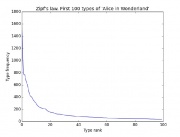Lecture 2. Tokenization and word counts
Ekaterina Chernyak, Dmitry Ilvovsky
Содержание
- 1 How many words?
- 2 Zipf's law
- 3 Heaps' law
- 4 Why tokenization is difficult?
- 5 Rule-based tokenization
- 6 Sentence segmentation
- 7 Natural Language Toolkit (NLTK)
- 8 Exercise 1.1 Word counts
- 9 Lemmatization (Normalization)
- 10 Stemming
- 11 Exercise 1.2 Word counts (continued)
- 12 Exercise 1.3 Do we need all words?
How many words?
"The rain in Spain stays mainly in the plain." 9 tokens: The, rain, in, Spain, stays, mainly, in, the, plain 7 (or 8) types: T = the rain, in, Spain, stays, mainly, plain
Type and token
Type is an element of the vocabulary.
Token is an instance of that type in the text.
N = number of tokens;
V - vocabulary (i.e. all types);
|V| = size of vocabulary (i.e. number of types).
How are N and |V| related?
Zipf's law
Zipf's law ([Gelbukh, Sidorov, 2001])
In any large enough text, the frequency ranks (starting from the highest) of types are inversely proportional to the corresponding frequencies:
f = 1/r
f — frequency of a type;
r — rank of a type (its position in the list of all types in order of their frequency of occurrence).
Heaps' law
Heaps' law ([Gelbukh, Sidorov, 2001])
The number of different types in a text is roughly proportional to an exponent of its size:
N = number of tokens;
|V| = size of vocabulary (i.e. number of types);
K, b — free parameters, K ∈ [10; 100]; b ∈ [0.4; 0.6]
Why tokenization is difficult?
- Easy example: "Good muffins cost $3.88 in New York. Please buy me two of them. Thanks."
- is \." a token?
- is $3.88 a single token?
- is \New York" a single token?
- Real data may contain noise in it: code, markup, URLs, faulty punctuation
- Real data contains misspellings: "an dthen she aksed"
- Period "." does not always mean the end of sentence: m.p.h., PhD.
Nevertheless tokenization is important for all other text processing steps.
There are rule-based and machine learning-based approaches to development of tokenizers.
Rule-based tokenization
For example, define a token as a sequence of upper and lower case letters: A-Za-z. Reqular expression is a nice tool for programming such rules.
RE in Python
In[1]: import re
In[2]: prog = re.compile('[A-Za-z]+')
In[3]: prog.findall("Words, words, words.")
Out[1]: ['Words', 'words', 'words']
Sentence segmentation
What are the sentence boundaries?
- ?, ! are usually unambiguous
- Period "." is an issue
- Direct speech is also an issue: She said, "What time will you be home?" and I said, "I don't know!". Even worse in Russian!
Let us learn a classifier for sentence segmentation.
Binary classifier
A binary classifier f : X ⇒ 0; 1 takes input data X (a set of sentences) and decides EndOfSentence (0) or NotEndOfSentence (1).
What can be the features for classification? I am a period, am I EndOfSentence?
- Lots of blanks after me?
- Lots of lower case letters and ? or ! after me?
- Do I belong to abbreviation?
- etc.
We need a lot of hand-markup.
Natural Language Toolkit (NLTK)
Do we need to program this? No! There is Natural Language Toolkit (NLTK) for everything.
NLTK tokenizers
In[1]: from nltk.tokenize import RegexpTokenizer,
wordpunct tokenize
In[2]: s = 'Good muffins cost $3.88 in New York. Please buy me two of them. Thanks.'
In[3]: tokenizer = RegexpTokenizer('\w+ | \$ [\d \.]+ | S \+')
In[4]: tokenizer.tokenize(s)
In[5]: wordpunct tokenize(s)
Learning to tokenize
nltk.tokenize.punkt is a tool for learning to tokenize from your data. It includes pre-trained Punkt tokenizer for English.
Punkt tokenizer
In[1]: import nltk.data
In[2]: sent detector = nltk.data.load('tokenizers/punkt/english.pickle')
In[3]: sent detector.tokenize(s)
Exercise 1.1 Word counts
Input: Alice in Wonderland (alice.txt) or your text
Output 1: number of tokens
Output 2: number of types
Use nltk.FreqDist() to count types. nltk.FreqDist() is a frequency dictionary: [key, frequency(key)].
Lemmatization (Normalization)
Each word has a base form:
- has, had, have ⇒ have
- cats, cat, cat's ⇒ cat
- Windows ⇒ window or Windows?
Lemmatization [Jurafsky, Martin, 1999]
Lemmatization (or normalization) is used to reduce in ections or variant forms to base forms. A dictionary with headwords is required.
Lemmatization
In[1]: from nltk.stem import WordNetLemmatizer
In[2]: lemmatizer = WordNetLemmatizer()
In[3]: lemmatizer.lemmatize(t)
Stemming
A word is built with morphems: word = stem + affixes. Sometimes we do not need affixes.
translate, translation, translator ⇒ translat
Stemming [Jurafsky, Martin, 1999]
Reduce terms to their stems in information retrieval and text classification. Porter's algorithm is the most common English stemmer.
Stemming
In[1]: from nltk.stem.porter import PorterStemmer
In[2]: stemmer = PorterStemmer()
In[3]: stemmer.stem(t)
Exercise 1.2 Word counts (continued)
Input: Alice in Wonderland (alice.txt) or your text
Output 1: 20 most common lemmata
Output 2: 20 most common stems
Use FreqDist() to count lemmata and stems. Use FreqDist().most common() to find most common lemmata and stems.
Exercise 1.3 Do we need all words?
Stopword is a not meaningful word: prepositions, adjunctions, pronouns, articles, etc.
Stopwords
In[1]: from nltk.corpus import stopwords
In[2]: print stopwords.words('english')
Exercise 1.3
Input: Alice in Wonderland (alice.txt) or your text
Output 1: 20 most common lemmata without stop words
Use not in operator to exclude not stopwords in a cycle.

